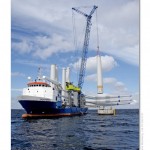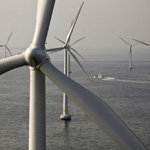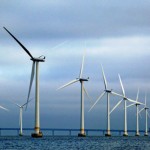 Poland could be adding €17.5 billion (PLN 73.8 billion) to its economy by 2025 if it develops its offshore wind energy sector to a potential six gigawatts, a new report by Ernst & Young has revealed.
Poland could be adding €17.5 billion (PLN 73.8 billion) to its economy by 2025 if it develops its offshore wind energy sector to a potential six gigawatts, a new report by Ernst & Young has revealed.
The report, “offshore wind energy – analysis of benefits for the Polish economy and development determinants”, also said that the sector could potentially create 31.8 thousand new jobs from 2012-2025, mostly in the electro-engineering sector. Moreover, sectors badly affected by the economic crisis – maritime transport, shipbuilding and port industries – could gain five thousand new jobs by 2025, said the report.
Currently the country’s offshore wind energy target is for 500 MW by 2020, but the potential is far higher, says Wojciech Cetnarski, President of the Polish Wind Energy Association (PWEA). The 500 MW target “seems underestimated”. “Last year’s amendments to the legislative framework (the Act on Maritime Areas and Maritime Administration) increased the interest of national and foreign investors,” Cetnarski added.
6 GW of offshore wind power would also avoid the emission of around 40 million tonnes of carbon dioxide, creating a saving of €0.4 billion (PLN 1.6 billion), the report says.
Meanwhile, an expansion of Polish offshore wind is expected to reduce electricity production costs. Based on trends forecast in the UK, the cost of production of 1 MWh in offshore wind farms commissioned in 2011 is around €170, a level set to fall by 29% if the UK reaches 18 GW of offshore wind by 2020. “In the case of Poland, the decrease may be higher for the country has better natural conditions for the construction of offshore wind farms,” the PWEA press release said.
Attend EWEA OFFSHORE 2013 in Frankfurt this November to get the latest knowledge on offshore wind.
 While the wind industry will never face the equivalent of a Deepwater oil spill or a Fukushima nuclear catastrophe, its spectacular growth rates over the last decade do mean there are more health and safety hazards.
While the wind industry will never face the equivalent of a Deepwater oil spill or a Fukushima nuclear catastrophe, its spectacular growth rates over the last decade do mean there are more health and safety hazards.
An electrical fire can occur; heavy parts can fall from great heights; lifting huge unstable loads with cranes could go wrong; transferring workers from vessels to an offshore turbine in wavy conditions could be dangerous and, when an accident occurs in a remote wind farm, rescue can take longer.
continue reading »

Ed Davey
While debate in the media rages on whether the UK’s green energy policies will raise electricity bills or not, Ed Davey, UK Secretary of State for Energy and Climate Change, has said that onshore and offshore wind power together cost householders only £18 a year in total, according to a Guardian article.
Moreover, Davey said that wind power is needed for the UK’s energy mix to insulate it from global gas prices: “Global gas price hikes are squeezing households. They are beyond any government’s control. The analysis shows that our strategy of shifting to alternatives like renewables and of being smarter with how we use energy is helping those who need it most to save money on their bills.”
The same article noted that UK government analysis published on Wednesday shows that 85% of the current average UK electricity bill (£1,250/year) cannot be controlled by the government because it is determined by international gas and electricity prices, transmission and metering costs.
continue reading »
 One of the world’s largest offshore wind farms came a step closer to reality in recent weeks as suction-installed foundations for the project left their Irish shipyard to begin their journey to the site of the Dogger Bank wind farm, 125 kilometres off the UK’s east coast.
One of the world’s largest offshore wind farms came a step closer to reality in recent weeks as suction-installed foundations for the project left their Irish shipyard to begin their journey to the site of the Dogger Bank wind farm, 125 kilometres off the UK’s east coast.
The structures, known as bucket foundations, can reduce costs as there is no need for transition piece costs or additional grouting as would be the case for more traditional foundations.
They are literally gigantic steel buckets that will sink solidly into the sea floor using a suction method and jetting systems, as opposed to floating or more conventional monopole, jacket or tripod foundations which are generally tethered to the seabed. –
continue reading »
 Still reeling from the earthquake and tsunami that destroyed the Fukushima nuclear plant in 2011, Japan has announced its intention to build what could become the world’s largest offshore wind farm.
Still reeling from the earthquake and tsunami that destroyed the Fukushima nuclear plant in 2011, Japan has announced its intention to build what could become the world’s largest offshore wind farm.
New Scientist reported last week that the world’s third largest economy plans to build by 2020 an offshore wind farm with 143 turbines 16 kilometres from the destroyed Daiichi nuclear reactor.
The new wind farm will generate 1 gigawatt of power once completed, the magazine said, adding it is part of a Japanese plan to increase renewable energy resources following the post-tsunami shutdown of the nation’s 54 nuclear reactors. Currently, two of those reactors have come back online.
“The project is part of the Fukushima region’s plan to become completely energy self-sufficient by 2040, using renewable sources alone,” the article said.
continue reading »
 Poland could be adding €17.5 billion (PLN 73.8 billion) to its economy by 2025 if it develops its offshore wind energy sector to a potential six gigawatts, a new report by Ernst & Young has revealed.
Poland could be adding €17.5 billion (PLN 73.8 billion) to its economy by 2025 if it develops its offshore wind energy sector to a potential six gigawatts, a new report by Ernst & Young has revealed.









